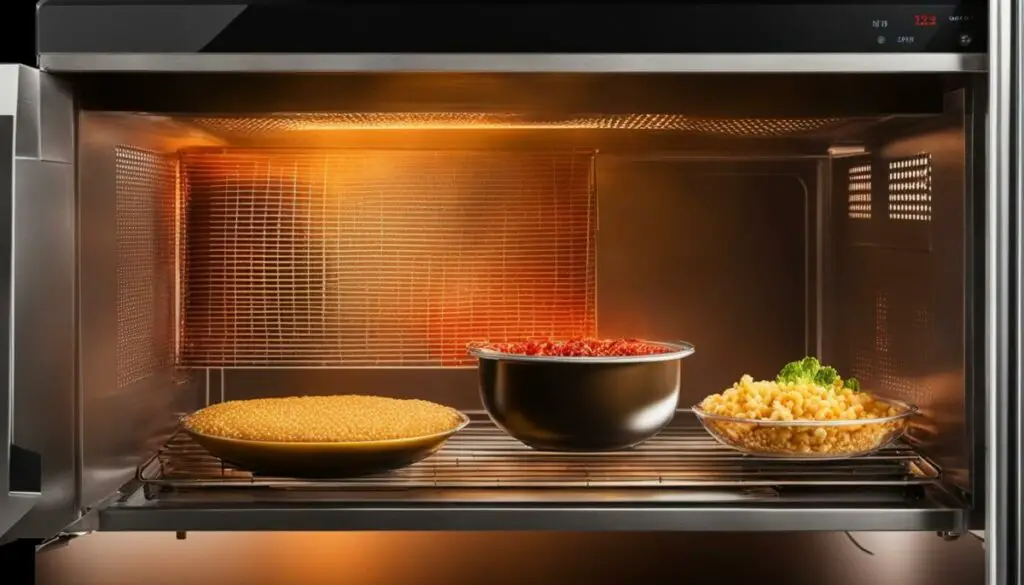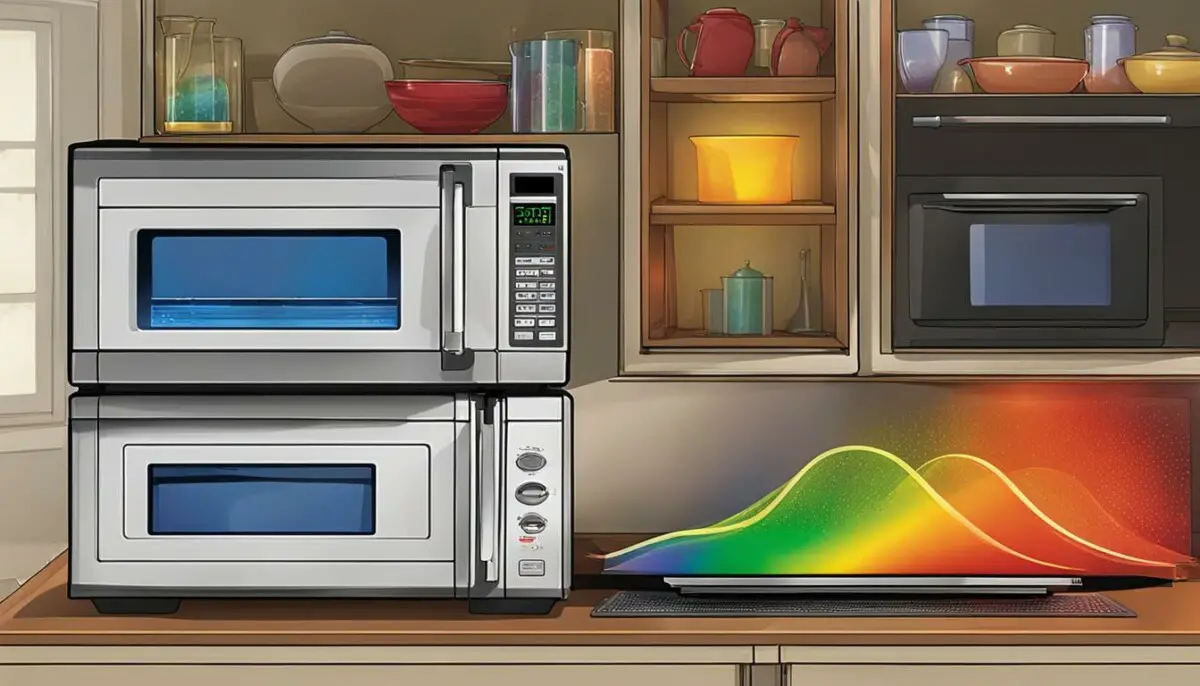Last Updated on 5 months by Francis
Welcome to our exploration of the fascinating world of electromagnetic waves. In this section, we will delve into the question of whether microwaves are a type of infrared wave. The concept of electromagnetic radiation can be confusing, but we will break it down into easy-to-understand sections to provide a clearer understanding of the relationship between microwaves and infrared waves.
Contents
Key Takeaways:
- Electromagnetic radiation encompasses a wide spectrum of waves, including microwaves and infrared waves.
- The relationship between microwaves and infrared waves is complex but distinguishable.
- Microwave technology is widely used in everyday life, while infrared waves are utilized in specialized applications.
- The benefits and limitations of microwave technology and infrared waves must be carefully considered for optimal usage.
Understanding the Electromagnetic Spectrum
Before delving into the intricacies of microwave technology, it’s important to understand the electromagnetic spectrum. This spectrum is a range of electromagnetic radiation that includes all types of electromagnetic waves, such as radio waves, microwaves, infrared waves, visible light, ultraviolet radiation, X-rays, and gamma rays.
Each type of wave in the electromagnetic spectrum has a unique wavelength, frequency, and energy level. Microwave technology operates within the microwave region of the spectrum, which ranges from approximately 1 millimeter to 1 meter in wavelength.
This region of the spectrum is particularly useful for communication and energy transfer due to the ability of microwaves to penetrate materials like clouds, smoke, and walls. Microwave technology has a range of applications, from telecommunications to cooking food in microwave ovens.
Regions of the Electromagnetic Spectrum
| Region | Wavelength Range (m) | Frequency Range (Hz) |
|---|---|---|
| Radio Waves | 10^2 – 10^5 | 10^3 – 10^9 |
| Microwaves | 10^-3 – 1 | 10^9 – 10^12 |
| Infrared Waves | 7 x 10^-7 – 10^-3 | 3 x 10^12 – 4 x 10^14 |
| Visible Light | 4 x 10^-7 – 7 x 10^-7 | 4 x 10^14 – 7.5 x 10^14 |
| Ultraviolet Radiation | 10^-8 – 4 x 10^-7 | 7.5 x 10^14 – 3 x 10^16 |
| X-rays | 10^-11 – 10^-8 | 3 x 10^16 – 10^19 |
| Gamma Rays | > 10^19 |
As we can see from the table above, microwaves have a higher frequency and shorter wavelength than radio waves, but a lower frequency and longer wavelength than infrared waves. This unique range of characteristics makes microwaves ideal for various forms of technology, including microwave ovens and satellite communication.
Next, we’ll take a closer look at microwaves and how they work in microwave ovens.
Microwaves: A Closer Look

When we think of microwaves, we often associate them with the ubiquitous kitchen appliance that has revolutionized the way we cook and reheat food. However, microwaves have uses beyond the kitchen and are utilized in a variety of industries, including telecommunications, medical treatments, and materials processing.
Microwaves are a form of electromagnetic radiation that falls between radio waves and infrared radiation on the electromagnetic spectrum. They have a wavelength ranging from 1 millimeter to 1 meter and a frequency in the range of 300 MHz to 300 GHz. This unique combination of wavelength and frequency allows microwaves to penetrate materials and generate heat, making them essential in microwave ovens.
Microwave ovens work by generating microwave radiation, which is then absorbed by the food, causing the water molecules within it to vibrate and generate heat. This process is known as dielectric heating and is incredibly efficient, as it heats the food from the inside out. However, it is important to note that microwave radiation can be harmful in large amounts and proper safety precautions must be followed when using microwave ovens.
Aside from their use in microwave ovens, microwaves have a variety of other applications. They are used in radar technology for weather forecasting and air traffic control, as well as in satellite communications for transmitting and receiving signals. Microwaves are also used in medical treatments, such as cancer therapy, and in materials processing for curing resins and drying textiles.
The Dangers of Microwave Radiation
While microwaves have many useful applications, it is important to note that they can also pose risks, particularly if not used properly. Microwave radiation is a form of non-ionizing radiation, which means it does not have enough energy to ionize atoms or molecules and cause cancer. However, exposure to high levels of microwave radiation can still cause harm, including burns, cataracts, and other health issues.
To minimize the risks of microwave radiation, it is important to follow proper safety procedures when using a microwave oven. This includes not standing too close to the oven while it is in use, not heating certain materials that can ignite, and not attempting to repair a microwave oven on your own.
Exploring Infrared Waves

Infrared radiation, commonly known as infrared waves, are a type of electromagnetic radiation that falls between visible light and microwaves in the electromagnetic spectrum. Unlike visible light, infrared waves are invisible to the human eye. Instead, we perceive them as heat or warmth.
Infrared waves have longer wavelengths and lower frequencies than visible light, making them ideal for heating and sensing applications. They are emitted by any object that has a temperature above absolute zero and are detected by specialized sensors, commonly used in thermal imaging and remote temperature measurement.
| Characteristics of Infrared Waves | |
|---|---|
| Wavelength | 0.7μm – 1mm |
| Frequency | 300 GHz – 400 THz |
| Energy | 1.24 meV – 1.68 eV |
One of the most common applications of infrared waves is in temperature measurement, where thermal cameras use infrared radiation to detect heat signatures from objects in their field of view. This technology is used in a wide range of industries, from aerospace and defense to medical and automotive.
Another use of infrared radiation is in remote control systems, where infrared waves are used to transmit signals to electronic devices such as televisions, DVD players, and audio systems. Infrared radiation is also used in fiber optic communications, where it can transmit information over long distances with minimal signal loss.
Overall, infrared waves are essential in many everyday products and technologies that we use. From detecting temperature to transmitting information, infrared radiation has a wide range of applications that make our lives easier and more efficient.
Overlapping Properties of Microwaves and Infrared Waves

While there are many differences between microwaves and infrared waves, they share some important properties and applications.
One of the key similarities is their ability to generate heat. Both microwaves and infrared waves are commonly used in heating applications because they can selectively target certain materials and generate heat quickly and efficiently.
In fact, one of the most common uses of microwave technology is in microwave ovens, which use microwaves to heat food by exciting water molecules and generating heat through friction. Similarly, infrared waves are often used in heating systems, such as outdoor patio heaters, which use infrared radiation to directly heat objects without heating the surrounding air.
Another shared property between microwaves and infrared waves is their use in telecommunications. Microwaves are frequently used in cell phone and satellite communications, while infrared waves are used in remote controls for TVs and other electronic devices.
Overall, while microwaves and infrared waves have distinct differences, they share some important properties and have many overlapping applications in our daily lives and in various industries.
Microwave Heating Mechanisms

In this section, we will explore the science behind microwave heating, highlighting the role of water molecules in the process. Microwave heating is a highly efficient process that utilizes microwaves to generate heat within the food. At a molecular level, microwave radiation causes water molecules to rotate and vibrate, generating heat through friction between the molecules.
This process is known as dielectric heating and is the primary mechanism behind microwave heating. The efficiency of this process is due to the fact that water molecules are polar, which means they have a positive and negative charge. This polar nature allows them to absorb microwave radiation and generate heat more quickly than other molecules.
It is worth noting that some microwave ovens may also use other heating mechanisms, such as convection heating or radiant heating. These methods work in tandem with microwave heating to help ensure food is cooked evenly and thoroughly.
“Microwave heating is a highly efficient process that utilizes microwaves to generate heat within the food.”
Benefits of Microwave Heating
Microwave heating offers several advantages over conventional cooking methods, including:
- Speed: Microwaving is much faster than conventional cooking methods, helping to save time in the kitchen.
- Efficiency: Microwave heating is highly efficient, meaning that less energy is wasted during the cooking process.
- Convenience: Microwaves are easy to use and allow for quick and simple meal preparation.
Limitations of Microwave Heating
While microwave heating is a useful tool in the kitchen, there are some limitations to its use. Some of these limitations include:
- Uneven heating: Microwaves can heat some areas of food more quickly than others, leading to uneven cooking.
- Texture changes: Some foods may become rubbery or tough when cooked in a microwave.
- Food safety concerns: Improper use of a microwave can lead to foodborne illness, as microwaves may not always heat food evenly or to a high enough temperature to kill harmful bacteria.
Infrared Waves in Everyday Life

Infrared waves are all around us, present in various aspects of daily life. Here are a few common examples of how infrared technology is utilized:
| Application | Explanation |
|---|---|
| Remote controls | Remote controls for televisions, air conditioners, and other devices commonly use infrared waves to transmit signals to the receiver. |
| Thermal imaging | Infrared cameras can detect body heat and create thermal images, which are used in medicine, law enforcement, and home energy inspections. |
| Heaters | Infrared heaters use infrared radiation to generate heat, providing warmth in homes, patios, and commercial spaces. |
| Security systems | Infrared sensors are used in security systems to detect movement and trigger alarms. |
As we can see, infrared waves have a variety of practical applications, contributing to our daily comfort, safety, and well-being.
Microwaves and Infrared Waves: Different but Related
While microwaves and infrared waves share some similarities, they are distinct in many ways. One of the main differences is in their wavelength. Microwaves have longer wavelengths than infrared waves, meaning they have lower frequencies and less energy. This difference in wavelength is what makes microwave ovens and infrared heaters operate differently.
Another difference is in their applications. Microwaves are primarily used for cooking and heating food in a microwave oven, while infrared waves are used in a variety of applications such as remote controls, thermal imaging, and heating systems.
Despite these differences, microwaves and infrared waves are related in that they are both types of electromagnetic radiation. They are part of the same spectrum of energy that includes everything from radio waves to gamma rays. To better understand this relationship, let’s take a closer look at the electromagnetic spectrum:
| Type of Wave | Wavelength Range | Frequency Range |
|---|---|---|
| Radio Waves | 1 millimeter to 100 kilometers | 300 GHz to 3 kHz |
| Microwaves | 1 millimeter to 1 meter | 300 GHz to 300 MHz |
| Infrared Waves | 700 nanometers to 1 millimeter | 430 THz to 300 GHz |
| Visible Light | 400 to 700 nanometers | 750 THz to 430 THz |
| Ultraviolet Waves | 10 to 400 nanometers | 3 PHz to 750 THz |
| X-Rays | 0.01 to 10 nanometers | 30 EHz to 3 PHz |
| Gamma Rays | Less than 0.01 nanometers | More than 30 EHz |
As you can see from the table, microwaves and infrared waves occupy distinct regions of the electromagnetic spectrum. However, both types of radiation have important and varied uses in science, industry, and everyday life.
Benefits and Limitations of Microwave Technology

Microwave technology has become an indispensable part of modern living, providing rapid and efficient heating solutions to our daily needs. Microwave ovens are found in almost every home and have revolutionized the way we prepare food. However, as with any technology, there are both advantages and limitations to consider when using microwave technology.
Advantages of Microwave Technology:
- Speed: Microwave ovens are incredibly fast at heating food. They can cook or heat food in a matter of minutes, making them a convenient option for people with busy schedules.
- Efficiency: Microwave ovens use less energy than conventional ovens, making them an eco-friendly option for heating food.
- Convenience: Microwave ovens are easy to use and require minimal preparation time. You can simply place your food in the oven, set the timer, and heat your meal without any hassle.
- Versatility: Microwave ovens can be used for a range of cooking tasks, such as defrosting, reheating, and cooking full meals.
Limitations of Microwave Technology:
- Uneven Heating: Due to the way microwaves work, food can sometimes be heated unevenly, resulting in hot spots or undercooked areas. It’s important to stir or rotate your food to ensure even heating.
- Limited Cooking Options: Microwave ovens are not suitable for all types of cooking, such as baking or roasting, which require dry heat. They are best suited for heating or cooking moist foods.
- Potential Health Risks: While there is no conclusive evidence linking microwave ovens to negative health effects, some studies have suggested that prolonged exposure to microwave radiation can potentially be harmful. It’s important to follow best practices and safety guidelines when using a microwave oven.
Despite its limitations, microwave technology remains a convenient and efficient option for everyday heating needs. It’s important to weigh the benefits and limitations when deciding whether to use a microwave oven for a particular meal or cooking task.
The Role of Infrared Waves in Heating Systems

While microwaves rely on a different mechanism to generate heat in microwave ovens, infrared waves play a critical role in various heating systems, from outdoor patio heaters to infrared heaters.
Unlike microwaves, which generate heat by exciting the water molecules in food, infrared waves heat objects directly through a process known as thermal radiation. This means that infrared heating systems can provide warmth without actually heating the air between the heater and the person or object being heated. This makes them ideal for outdoor heating applications, as well as in commercial and industrial settings where localized heating is required.
Another advantage of infrared heaters is their energy efficiency. Since they heat objects directly rather than heating the air, less energy is wasted in heating the surrounding environment. This makes them an attractive option for businesses looking to reduce their energy consumption and lower their carbon footprint.
Some types of infrared heating systems utilize infrared radiation to provide targeted heating. For example, some outdoor patio heaters use ceramic infrared heating elements that emit infrared radiation in a specific wavelength range, heating only the people and objects within the immediate vicinity of the heater. This allows for more efficient use of energy and can help reduce heating costs.
Overall, the unique properties of infrared waves make them a powerful tool in heating systems, providing energy-efficient and targeted warmth in a variety of settings.
Applications of Microwaves and Infrared Waves in Science and Industry
The use of microwaves and infrared waves extends far beyond the kitchen and home appliances. Both technologies play a crucial role in scientific research, industry, and many other fields. Here are just a few examples of their diverse range of applications:
Microwave Technology
Microwave technology is widely used for communication purposes, with satellites and cell phones being the most commonly recognized examples. However, microwaves also play a critical role in remote sensing, where they are used to measure properties of the earth’s surface and atmosphere. This technology is particularly useful for weather forecasting, environmental monitoring, and disaster relief efforts. Microwaves are also employed in materials processing, such as drying, curing, and welding. In the medical field, they are used for both diagnosis and treatment, with microwave ablation being a common technique for cancer therapy.
Infrared Waves
Infrared waves are utilized in a variety of fields, from manufacturing to medicine. In industry, infrared radiation is used for thermal imaging, allowing for detailed analysis of heat distribution and energy efficiency. It is also used for temperature control in industrial processes, such as heating and drying. In the medical field, infrared waves are used for both diagnosis and treatment, with infrared thermography being a common technique for detecting breast cancer. Infrared waves are also used in security systems and fire detection, where they can detect temperature changes and movement.
Combining Microwaves and Infrared Waves
The combination of microwaves and infrared waves can lead to even more powerful applications. For example, microwave-assisted synthesis is a technique that involves using both microwaves and infrared radiation to drive chemical reactions. This approach has been shown to significantly reduce reaction times and improve product yields. In the food industry, combining microwave and infrared heating can lead to more efficient and precise cooking, with improved food quality and reduced energy consumption.
| Applications | Microwaves | Infrared Waves |
|---|---|---|
| Communication | ✓ | |
| Remote Sensing | ✓ | |
| Materials Processing | ✓ | |
| Medical Diagnosis | ✓ | ✓ |
| Medical Treatment | ✓ | ✓ |
| Thermal Imaging | ✓ | |
| Temperature Control | ✓ | |
| Security Systems | ✓ | |
| Fire Detection | ✓ |
Table: Applications of Microwaves and Infrared Waves in Various Industries (adapted from Chen et al., 2019)
As these examples show, microwaves and infrared waves are essential technologies that have revolutionized many different fields. From communication and materials processing to medical diagnosis and treatment, these waves are a powerful tool for scientists and engineers alike.
Conclusion
In conclusion, we have explored the fascinating world of microwaves and infrared waves, taking a closer look at their properties, uses, and interactions with various materials. Through our investigation, we have determined that while microwaves and infrared waves share some similarities, they are distinct types of radiation with unique characteristics and applications.
Overall, microwave technology has revolutionized the way we cook and heat food, providing a faster and more efficient alternative to conventional methods. However, it is important to exercise caution when using microwave ovens, as exposure to microwave radiation can have harmful effects on human health.
Infrared waves, on the other hand, are utilized in a variety of applications beyond cooking, including remote controls, thermal imaging, and heating systems. Their ability to generate heat without contact and their use in outdoor heating devices make them an attractive option for many industries.
While there is no definitive answer to the initial question of whether microwaves are a type of infrared wave, we have demonstrated that these two forms of radiation occupy distinct regions of the electromagnetic spectrum and have different wavelengths, frequencies, and energy levels.
Overall, both microwaves and infrared waves are integral to our daily lives, playing a critical role in everything from communications to materials processing. By continuing to study and explore their properties, we can unlock even more benefits and applications for these remarkable forms of energy.
FAQ
Are microwaves a type of infrared wave?
No, microwaves and infrared waves are two distinct types of electromagnetic waves. While both are part of the electromagnetic spectrum, they have different wavelengths, frequencies, and properties.
What is the electromagnetic spectrum?
The electromagnetic spectrum is the range of all possible frequencies of electromagnetic radiation. It includes various types of waves, such as radio waves, microwaves, infrared waves, visible light, ultraviolet rays, X-rays, and gamma rays.
What are microwaves and how do they work?
Microwaves are a form of electromagnetic radiation with wavelengths ranging from about 1 millimeter to 1 meter. In microwave ovens, microwaves generate heat by causing water molecules in food to vibrate, leading to friction and the generation of thermal energy.
What are infrared waves and how are they used?
Infrared waves have wavelengths longer than those of visible light and shorter than microwaves. They are widely used in applications such as remote controls, thermal imaging, heating systems, and communication systems. Infrared waves can be detected by special sensors that convert them into electrical signals.
Do microwaves and infrared waves have any similarities?
While microwaves and infrared waves have different wavelengths and frequencies, they both have the ability to generate heat. This shared property makes them useful in applications such as cooking, heating, and materials processing.
How do microwaves interact with food to produce heat?
Microwaves primarily interact with water molecules in food. They cause the water molecules to rotate and collide with each other, generating heat throughout the food. This process is known as dielectric heating.
Where do we encounter infrared waves in our daily lives?
Infrared waves are present in various aspects of everyday life. They are used in remote controls for televisions and other electronic devices. Infrared cameras and thermal imaging devices also rely on infrared waves to detect and visualize heat patterns.
How do microwaves and infrared waves differ?
Microwaves and infrared waves differ in terms of their wavelengths, frequencies, and applications. Microwaves have longer wavelengths and lower frequencies than infrared waves. Microwaves are commonly used for cooking and communication, while infrared waves find applications in heating, remote sensing, and imaging.
What are the benefits and limitations of microwave technology?
Microwave technology offers advantages such as fast and convenient heating, energy efficiency, and precise temperature control. However, limitations include uneven heating in certain foods, potential safety hazards if not used correctly, and limited penetration depth in some materials.
How are infrared waves utilized in heating systems?
Infrared waves are used in heating systems, such as infrared heaters and outdoor patio heaters, to directly heat objects and people without heating the surrounding air. This method provides focused and efficient heat transfer, making it suitable for outdoor and targeted heating applications.
What are some common applications of microwaves and infrared waves?
Both microwaves and infrared waves have numerous applications across science, industry, and everyday life. Microwaves are utilized in telecommunications, radar systems, and satellite communications. Infrared waves find use in security systems, industrial process monitoring, and medical imaging, among other fields.








